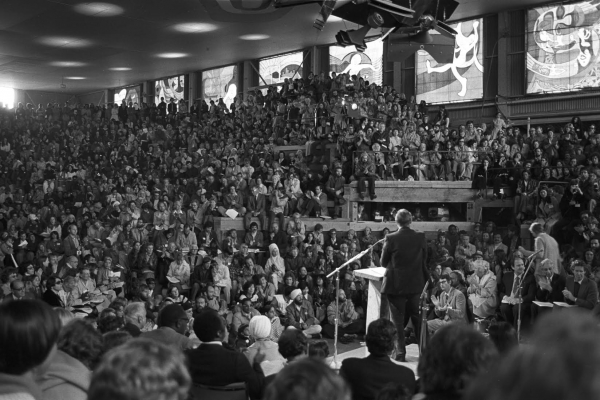Back in 1976, when Habitat I was held in Vancouver, most institutions, including governments and academia were unaware of the impact of urbanization on development. By the time of Habitat II in Istanbul 20 years later, it was clear that the massive migration to cities and their consequent growth needed to be addressed. Despite initial resistance, urbanization started to be seen as a driver for development. Another 20 years have passed. Now, the role urbanization will play in all our futures is clearly evident.
As we write, some 36,000 people from around the globe are meeting in Quito, Ecuador for Habitat III to discuss the impact of urbanization and push their national governments into signing a New Urban Agenda. What does this agenda mean and how will foundations be involved?
Development and sustainability have been thoroughly discussed in recent years. The Climate Change summits have had a fundamental role in raising awareness of the crossroads to which we have brought the planet. So much so that last year, governments agreed on two milestone commitments: The Sustainable Development Goals (SDGs, also known as Agenda 2030) and the Paris Agreement on Climate Change, the latter covered extensively in the June issue of Alliance.
Though cities occupy only 2 per cent of the planet´s surface, they are responsible for over 60 per cent of the global energy consumption and generate at least 70 per cent of the greenhouse gas emissions. Moreover, by 2050, the urban population is projected to be bigger than the current global population. This is why the United Nations system has been preparing, in the past three years, for another milestone summit: Habitat III, the United Nations Conference on Housing and Sustainable Urban Development.
The main purpose of Habitat III is to strengthen core messages about cities and human settlements. According to the draft declaration that will be signed by the 159 member states, cities must be ‘just, safe, healthy, accessible, affordable, resilient, and sustainable’ and ‘foster prosperity and quality of life for all’, not just for town-dwellers. The declaration goes on to claim that: ‘the New Urban Agenda will help to end poverty and hunger in all its forms and dimensions, reduce inequalities, promote sustained, inclusive, and sustainable economic growth, achieve gender equality and the empowerment of all women and girls, in order to fully harness their vital contribution to sustainable development, and improve human health and well-being, as well as foster resilience and protect the environment.’
What should philanthropy’s role be?
Though they often don’t realize it, foundations’ work in many areas – for example, education, youth, employment, capacity-building – is influenced by urbanization. Examples of foundations´ work in cities abound and are as diverse as foundations themselves. Philanthropic investment has historically supported the innovation necessary for pushing the boundaries of sustainability. Examples include the education of women and girls in rural areas so they can place their goods in urban marketplaces, to advocacy for informal workers’ recognition in waste management systems of big (and small) cities in Latin America, Africa or Southeast Asia.
Convinced that Habitat III represents a great opportunity to shape urban policy and, at the same time, offer the tools to realize the groundbreaking vision embedded in the SDGs and the Paris Agreement, Fundación Avina and the Ford Foundation have taken on the challenge of leading the Foundations and Philanthropies Constituent Member Group (GSC) of the General Assembly of Partners (GAP)[1]. This is a special initiative of the World Urban Campaign, which aims to support stakeholder engagement and contributions to the conference.
The GSC has enlisted the support of international and global philanthropic associations and networks such as the Mexican Center for Philanthropy (Centro Mexicano para la Filantropía – CEMEFI), Funders Forum on Sustainable Cities/European Foundation Centre, Foundations and Corporations Group (GDFE) in Argentina, Institutes, Foundations and Corporations Group (GIFE) in Brazil and WINGS.
Besides participating in the construction of the GAP outcome document, Partnerships for the New Urban Agenda, foundations have contributed an input paper to the New Urban Agenda.
Innovation with Purpose
Rapid urbanization has been accompanied by high levels of inequality, exclusion and extreme poverty, even in places where social and environmental resources are plentiful. The low quality of our democracies and the levels of citizen participation in governance point towards challenges of inclusion, justice and sustainability that no single actor has the answers to. Making sure that public goods are enjoyed by all human beings as a right requires a new spirit of collaboration and innovation, that we are calling Innovation with Purpose.
For us, this is a process that combines social, technological, and business innovation to accelerate and scale systemic changes. The effective transformation to an inclusive, sustainable, and equitable urban development set out in the New Urban Agenda cannot be achieved in a dispersed and fragmented society. It requires impacts at scale, reaching millions of people, which can only be fostered by comprehensive partnerships. Avina is convinced that Innovation with Purpose is the most promising way forward for the New Urban Agenda and the necessary coordination & collaboration at global, regional, national and local levels.
The foundation sector can be small when compared to governments or other sectors – almost a niche. Let´s make sure they keep on being a meaningful and essential one.
Oscar Fergutz is program director and Marcela Mondino is program manager at Fundación AVINA.
Emails Oscar.Fergutz@avina.net and Marcela.Mondino@avina.net.
Lead photo: The 24th Session of UN-Habitat’s Governing Council © UN-Habitat
Footnotes
- ^ GAP consists of 16 Partner Constituent Groups (PCG) with members from the United Nations’ major groups and other relevant stakeholders. See http://tinyurl.com/zb4xpje








Comments (0)